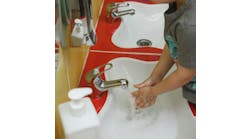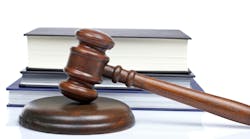Everyone wants kids to grow up smart. A child's educational success depends on good teachers, challenging curricula and involved parents. But student achievement also can be affected by the healthfulness of a school's environment.
That environment includes the restrooms that consume millions of gallons of water on campuses throughout the nation. Education institutions that embrace environmentally friendly products and technologies for restrooms can cut down on water and energy use, and save valuable resources.
A green path
At last year's annual meeting of the U.S. Conference of Mayors, the mayors cited studies that identified the benefits of learning in a green school and the urgent need for more healthful and productive places of learning. They noted the benefits of improved indoor air quality, including lower asthma rates, fewer allergies, reduced absenteeism and increased teacher retention rates.
The mayors also urged Congress to support K-12 green school demonstration projects and research to better understand the environmental, economic and health benefits of green schools. The consensus was that if schools and universities don't invest in more efficient, energy-saving products and installations, their cost of operations will increase, and student performance will suffer.
In a recent study, “Greening America's Schools: Costs and Benefits,” by Capital E, a national clean energy technology and green building firm, researchers found that a typical green school involves a 2 percent increase in cost, but provides financial benefits that are 20 times as large. The study of 30 green schools reported a savings of $100,000 a year in energy costs alone — enough to hire two teachers, or buy 500 computers or 5,000 textbooks.
The Capital E report also found that green schools reduced water use by about one-third. These savings help lower pollution and reduce costs to treat and transport wastewater. Water-saving strategies can save cities hundreds of thousands of dollars or more by deferring the need for infrastructure improvements such as stormwater detention and treatment facilities.
Many schools and universities already are aware of the importance of going green. According to a Green Building SmartMarket Report released by McGraw-Hill Construction in January 2007, the education market is not only the largest construction sector, but also the fastest-growing market for green building.
Hundreds of schools have applied for LEED certification from the U.S. Green Building Council, which administers the LEED rating system. The McGraw-Hill report also notes, however, that there remains “a strong need for access to and information on green building products” among school and academic administrators.
Restroom focus
Environmentally friendly products and technologies for restrooms have great potential for energy and water savings. Here are some strategies for high-performance restrooms:
-
Use technology
Because restrooms and locker rooms consume a lot of water, they should be a primary focus for improving water efficiency. Innovative technologies for toilets, faucets and other fixtures can help facilities earn LEED credits for water efficiency. Some newly constructed schools collect rainwater or gray water for toilet and urinal flushing or other non-potable functions.
Other water-saving strategies are relatively easy to achieve. Specifying low-flow fixtures, metered faucets and waterless urinals can reduce water consumption by more than 30 percent.
-
Use less water
Replacing toilets that use as much as 4.5 gallons per flush (gpf) and specifying low-volume toilets that use 1.6 gpf or less can save an estimated 14 percent in total school water use. Water-use requirements for faucets and lavatory systems vary from 2.2 gallons per minute (gpm) to 2.5 gpm depending on the plumbing or building code, but generally, lavatories in public restrooms should use just 0.5 gpm. Be sure to check your local codes and water-use requirements. Additional water savings can be achieved by installing sensor-activated flush meters.
Photovoltaic cells integrated into the top of a lavatory system can store and use energy collected from normal restroom lighting — and that energy can power the lavatory's sensors and valves. These units operate without batteries or electricity.
-
Low-maintenance locker rooms
In locker rooms, several manufacturers offer both low-flow lavatory faucets and low-flow showers. Another water-saving option is to specify infrared sensors on faucets to ensure that water is running only when users are washing their hands. The flow-rate limit for metered faucets is 0.25 gallons per cycle (gpc), which is the amount of water used during the time the faucet is activated.
Replacing metal lockers with solid plastic lockers means never having to paint them; they will last longer because they will not rust or deteriorate.
-
Replace outdated sinks and toilets
To save water and update the look of a facility, replace old sinks, toilets and urinals with more efficient models. By removing stained or cracked china lavs and replacing them with solid-surface lavatory systems, education institutions can make restrooms more attractive and functional.
Other features that save money and keep restrooms tidier are built-in soap dispensers that drip directly into the bowl and infrared sensors that shut off flow after use.
-
Shower solutions
To curb water usage, specify low-flow showerheads that use 2 gallons per minute (gpm). Because students are concerned about privacy, schools are replacing group or gang showers with private ones.
Alderson is a senior marketing manager for Bradley Corp., Menomonee Falls, Wis., a USGBC member and manufacturer of locker room products, plumbing fixtures, washroom accessories, partitions and emergency fixtures. She can be reached at (262)532-1096.

